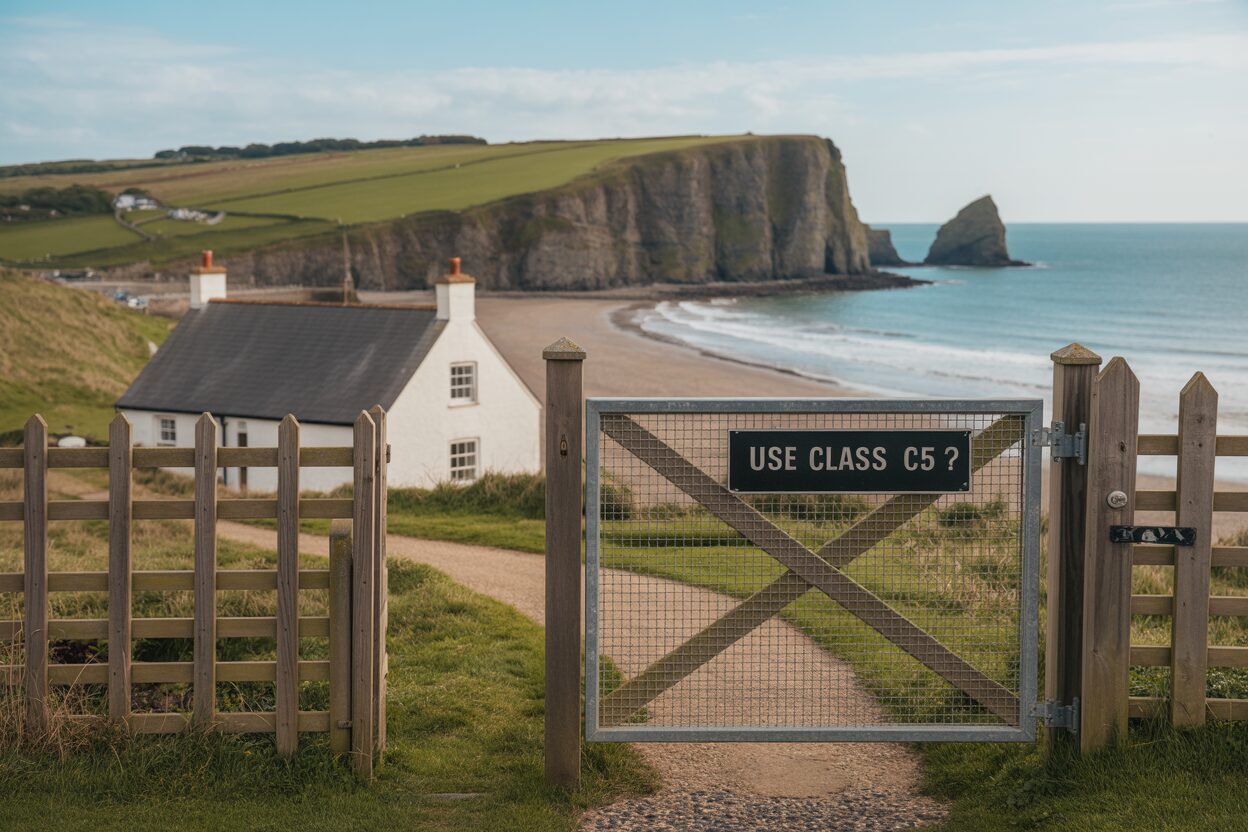
In February 2024, the then government announced plans to introduce a holiday let planning use class called C5. In January 2025, Labour party planning minister Matthew Pennycook said he wanted to speak about the idea with the Tories. He even mentioned possibly extending it to second homes. Since then, it’s all gone quiet. But that doesn’t mean it’s gone away.
In this article, find out the latest on the proposed Use Class C5. Find out the thinking behind the idea, how it might affect future holiday lets and where the government is right now with it.
What is the proposed Use Class C5?
The proposed Use Class C5 in England would be a new planning category for holiday lets. C5 would designate these properties as short-term lets not used as a sole or main home. Under the proposed law, existing dedicated short-term lets don’t need to apply for planning permission.
For existing properties already used as short-term lets, they would be reclassified automatically rather than needing permission.
Differences between C5, C3, and C1 use classes
The C5 Use Class will create a planning distinction between a holiday let, a persons’ sole or main home and hotels. See the key points below:
| Use Class | Description | Examples | Main Purpose | Key Points |
| C5 | Holiday lets and short-term rentals not used as a primary residence | Entire homes or apartments used wholly as short-term lets | Temporary stays for visitors and tourists | Proposed PD would allow change between C3 and C5 without an application, unless an Article 4 Direction removes that rightIntended to clarify rules for short-term lettingsApplies to properties offered as holiday letsDoes not cover sole or main residences |
| C3 | Standard residential dwellings used as main homes | Houses, flats, family homes occupied as primary residence by a single person or single household | Permanent living by households | Traditional residential useCovers main dwellings and family homesProposed PD to C5 unless restricted locally by Article 4 |
| C1 | Hotels and similar commercial accommodation | Hotels, guest houses | Commercial provision of accommodation to paying guests | Operates as a businessAccommodation with servicesRegulated as commercial premises |
H2: Why does the government think there is a need for Use Class C5?
0.85% of residential properties in England are holiday lets, according to Sykes (around 215,000 properties according to AirDNA data). The percentage is much higher in tourist regions like Cornwall, the Cotsworlds, the Lake District and coastal towns.
Many believe that the popularity of holiday homes leads directly to the following local issues:
- Unaffordable property prices: Families and younger people can not afford to stay in their home town. This drives long-term residents out and changes the social mix.
- Restricted local housing supply: There are fewer properties on the market. This reduces options for rental or home ownership for local people.
- Poorer community life: A diminished pool of permanent neighbours means fewer resident groups, community events and less volunteering. This leads to a lack of connection that affects residents’ quality of life.
- Reduced public services: GP surgeries, schools, and bus routes struggle as there is not the level of demand to keep them viable year-round.
- Off-season ghost towns: The average occupancy rate is 41.6% (self-catering), according to Savills. So, for just over 30 weeks a year, a property is empty. Off-peak, a property may go three months without a guest.
- Impaired business viability: Employing and retaining a local workforce on stable hours and contracts is a real challenge. Larger companies are less likely to locate close by because of the diminished talent pool.
Many holiday let owners feel the government unfairly blames them. As Landlord Zone reports, there are 719,500 vacant dwellings, of which 264,884 are long-term empty. That’s more than three times the number of short term rental properties.
Campaigners want England to replicate the system already in operation in Wales. Class C5 are dwellinghouses used as a second home, occupied for 183 days or fewer. Class C6 are dwellinghouses used for commercial short-term letting. The maximum stay in C6s per period of occupation is 31 days. Holiday lets fall under the C6 category.
Do holiday lets in England currently require planning permission?
It depends. You need planning permission if using a dwelling as holiday accommodation amounts to a material change of use. Your local planning authority decides, case by case, as a question of fact and degree, whether this is so as there is no statutory definition to guide decisions.
For example, you may need to get planning approval if you let the whole home for short stays during most of the year. Guests coming and going frequently, as well as cleaners and gardeners, will increase the levels of activity, noise and traffic. If it’s a larger property, the presence of multiple guest cars may cause issues with parking.
What often may sway the decision are the real-world impacts on the life of your neighbours. For example, in Moore (2012), the Court of Appeal confirmed that using a dwelling for short term holiday lets can be a material change of use. The court dismissed Moore’s appeal, meaning the council’s formal enforcement action was correct. The notice remained in force.
What if you’re planning right now to turn a home or flat into year-round guest accommodation? It’s best to factor in the possibility you may need to make a planning application. So, take professional advice from a planning consultant as soon as you can.
How would permitted development rights work under the holiday let planning use class C5?
The government has proposed a new class for short-term lets. At the same time, they set out two potential national permitted development routes: C3 to C5 and C5 to C3. This means you could:
- Switch between a standard dwelling and dedicated short-term let without planning permission, and vice versa
- Continue to let your sole or main home for up to 90 nights a year without planning permission (as proposed nationally)
Your local council could require you to apply for planning approval if your property is in an Article 4 Direction area. An Article 4 Direction is a planning control order that removes permitted development rights in a defined area.
At time of writing, these changes are nothing more than proposals. The Government hasn’t presented any secondary legislation, let alone a start date. The new law, if it comes into effect, will be an amendment to the Town and Country Planning (Fees for Applications, Deemed Applications, Requests and Site Visits) (England) Regulations 2012.
What is London’s temporary sleeping accommodation 90-night rule?
In Greater London, letting for more than 90 nights constitutes a material change of use and planning permission is required. Under the capital’s planning law, you’ll need formal permission from the borough to exceed the cap. This comes from section 44 of the Deregulation Act 2015 and GLA guidance.
You can use the 90-night exception only if:
- At least one person providing the accommodation is liable for council tax for the property.
- The total short-let nights do not exceed 90 in the year.
Fail either of those and you’ll need permission.
The 90 nights per calendar year covers paid stays or stays because of the guest’s employment. Boroughs do investigate and take enforcement action if a household breaches the rules. To protect yourself and prove compliance, keep booking records handy.
Will there be a mandatory national register or registration scheme?
The government proposed a registration scheme and a mandatory national register for short-term lets in their consultation paper. The register would allow councils to check if an owner had listed a property address as a short-term let (or serviced accommodation).
The idea behind the register is to address concerns about residential properties becoming holiday lets. Having a central database to work from would make it easier for local authorities to identify potential housing shortages in a local area.
If they spotted a problem, they could then introduce a planning rule like an Article 4 Direction to slow or stop the increase in the number of holiday lets in that area.
How do council tax and business rates work for holiday lets?
In England, you pay business rates if your property is available for short lets for at least 140 nights. You also need to actually let for at least 70 nights in the previous 12 months. Fail to meet that and you pay council tax.
How can local planning policy limit holiday lettings in hotspots?
Councils use Article 4 Directions to remove permitted development rights. These bring changes of use where you don’t need planning permission back into the normal planning process.
When deciding whether to declare an Article 4 Direction, councils consider:
- Local communities: Local people find themselves priced out or pushed out of neighbourhoods
- Local housing supply: There are fewer properties for local home ownership or renting.
- Local economy: Year-round businesses struggle when the peak trading season is so short.
- Amenity: Councils often cite the transient nature of occupation and frequent changeovers as a harm to neighbourhood character.
Authorities must target any plans proportionately to take account of local considerations. Expect tighter control in coastal towns, rural areas or Areas of Outstanding Natural Beauty.
Check your local plan before you list your property to stay ahead.
What enforcement can a council use if you operate a holiday let without consent?
Councils have these four tools they can use to control short-term lets in their boroughs:
- Article 4 Direction: Your council can take away the right to switch a home into a holiday let without planning permission. This only applies in certain streets or zones. They must explain why and keep the area as small as possible.
- Local plans: Councils can set out, in their local plans, that new homes must be lived in full-time or limit the number of short lets in an area. Authorities can defend these plans in court, as they did in RLT Built Environment Ltd v Cornwall Council [2016] EWHC 2817.
- Planning conditions: When you get planning permission, the council can set rules for your property, like “holiday use only.” They can also set limits on length of stay or require you to adhere to a plan for bins, noise and check-ins. These conditions are known as Section 106 agreements.
- Enforcement notices: If your short let counts as a material change of use, the council can issue a notice to stop it. Since 25 April 2024, most planning breaches in England have a 10-year limit. Temporary Stop Notices can now last up to 56 days.
What about Wales and Scotland compared to England?
Wales has a two use classes for short lets:
- C5 for second homes used 183 days or fewer
- C6 for commercial short lets of up to 31 days per stay
Both provide permitted development rights between C3, C5 and C6 that LPAs can withdraw via Article 4. Permitted development rights (PDRs) are a national grant of planning permission by Welsh ministers.
Scotland runs a national short-term let licensing scheme and allows control areas where secondary short-term letting is deemed a material change of use.
What has each party said about the proposed changes?
The previous Conservative government presented the proposal in February 2024. The current Labour government has said it supports tighter control and a stronger registration scheme. There are currently no signs they intend to enact it as national policy anytime soon.
HMO Architects: your partners in holiday let property portfolio building
Although Use Class C5 seems like another obstacle in the way of landlords, the truth is the proposals could have been much worse. Article 4 Directions are still quite rare so, in most parts of the country, this won’t affect you if this becomes a new planning system requirement.
HMO Architects has worked with over 750 developers and investors to build their property portfolios. We have an excellent track record in converting property to holiday use and securing planning permission.
Read our business plan for building a holiday rental business. While holiday lets and Airbnbs don’t deliver HMO returns, they are great for portfolio building.
Recent holiday cottage projects we’ve worked on include:
- Anfield Police Station, Liverpool (24 units): We converted a tired 20-bed HMO into a 24-room B&B/serviced stay geared to football fans by Anfield. Our architects added en-suites to every room and a ground-floor café while respecting the heritage of the building. We secured planning, rationalised the layout and delivered a themed “Cell Experience” offer. The value of the property rose from £450k to £1.2m and the rent jumped from £7,200 to £21,600 pcm over a 22-month programme.
- High Street, Cambridge (2 units): We adapted a semi-detached cottage into an Airbnb-ready short-stay, completing Building Control upgrades and a light interior overhaul. We also kept the plan flexible for a future HMO option. Value increased from £550k to £900k and rent from £1,800 to £3,800 pcm.
- Sandylands, Lancaster (7 units): We revived a six-storey seafront terrace into seven holiday-let apartments, optimising layouts for coastal views and addressing flood-risk feedback with safe escape routes via the planning consultant. The scheme rocketed from £90k to £550k in value with expected rent of £5,500 pcm once trading.
We provide a start-to-finish service for clients, including:
- Investment strategy call: Speak to Ryan Windsor, our Investment Director, about building a property portfolio. Ryan Windsor was 17 when he began building his own extensive property portfolio. Ask him about his BRRR method and how to use it as your investment strategy.
- Feasibility studies: Seen a single property you want to turn into a holiday let? Speak to Giovanni Patania, our Architecture Director. Get his expert feedback on and approach to pre-buy and design feasibility issues related to a property purchase you have in mind.
- Architectural services: Our team of architects has extensive holiday let experience. Let them create amazing spaces that maximise guest comfort without compromising your yield.
- Interior design: Balance aesthetics and durability to create stylish spaces that attract bookings while standing up to heavy guest use.
- On-site management: We can act as your Building Regulations Principal Designer (where required) to keep your holiday let project on track.
- Professional network: Access a range of brokers, lenders, surveyors and other experts to deliver your project on time and within budget.
View our range of development finance case studies to see how we’ve helped clients turn their ideas into sound investments. Read customer stories on HMO, flat, holiday let and housing projects.
Call us on 01223 776 997 or email us directly.
Giovanni is a highly accomplished architect hailing from Siena, Italy. With an impressive career spanning multiple countries, he has gained extensive experience as a Lead Architect at Foster + Partners, where he worked on a number of iconic Apple stores, including the prestigious Champs-Élysées flagship Apple store in Paris. As the co-founder and principal architect of WindsorPatania Architects, Giovanni has leveraged his extensive experience to spearhead a range of innovative projects.




